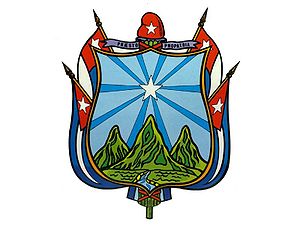Oriente Province
The Oriente (German East ) describes the eastern part of Cuba . This consists of the current provinces of Las Tunas , Granma , Holguín , Santiago de Cuba and Guantánamo , which were formed with the administrative reform of 1976. Oriente was previously one of six provinces in Cuba. At the time of Spanish colonial rule and until 1905, the region was known as the "Province of Santiago de Cuba ".
history
From the 17th to the 19th centuries, thousands of slaves were shipped to Cuba from sub-Saharan Africa . This also explains the high number of the black population.
The first revolts of the native Indian population against the Spanish conquerors began in the 16th century. The uprisings were led by the Indian chief Hatuey . But this was captured by the Spaniards and burned at the stake .
The uprisings did not start again until 300 years later, after the Spanish colonies on mainland America became independent. The initiator of the wars of independence was the plantation owner Carlos Manuel de Céspedes . He gave his slaves freedom on October 10, 1868. Céspedes issued a manifesto calling for the abolition of slavery and calling on the Cubans to fight Spain .
After conquering the city of Bayamo , the rebels set up a government. Céspedes became its president. The Ten Years War, in the course of which the first Cuban constitution was drawn up in 1869, ended in 1878 with the peace of Zanjón and the surrender of the rebels. Some rebels rejected the agreement, among them General Antonio Maceo . On February 24, 1895, the war against Spanish oppression was resumed. The leaders were José Martí , Máximo Gómez and Antonio Maceo. Little by little the rebels conquered Cuba. Even the high-ranking Spanish general Valeriano Weyler y Nicolau could no longer do anything against the rebels. On February 15, 1898 , when the Cubans had practically won, the American warship USS Maine exploded . The USA blamed Spain for the explosion and intervened in the war. On December 10th, the Treaty of Paris put an end to Spanish colonial rule in Cuba. On January 1, 1899, the last Spanish governor, Jiménez y Castellanos officially handed over the keys of Havana to the US General John R. Brooke . From this point on, Cuba was practically a colony of the USA (compare Open door policy ).
Some other historically significant Cubans come from this province. The president and later dictator Fulgencio Batista was born in Banes and the brothers Fidel and Raúl Castro in Birán , all in what is now the province of Holguín .
Another revolution began on December 2, 1956. This time against the US-backed dictator Batista . Under the leadership of Fidel Castro, this dictatorship ended on January 1, 1959 (see Cuban Revolution ).
In 1976, as part of an administrative reform , the province was split into the present-day provinces of Holguín , Las Tunas , Granma , Santiago de Cuba and Guantánamo .
economy
The economy in Oriente consists largely of agricultural products such as sugar cane, sweet potatoes, bananas, coffee and cocoa. After the collapse of the Eastern Bloc, sugar production also fell. In addition to agricultural products, various iron ores are also mined, e.g. E.g. nickel and chromium. Another branch of the economy grew in the 1990s: tourism. This is becoming more and more important for Cuba.
